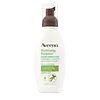What's inside
What's inside
 Key Ingredients
Key Ingredients

 Benefits
Benefits

 Concerns
Concerns

 Ingredients Side-by-side
Ingredients Side-by-side

Glycerin
HumectantWater
Skin ConditioningMyristic Acid
CleansingStearic Acid
CleansingLauric Acid
CleansingPotassium Cocoate
EmulsifyingPotassium Hydroxide
BufferingPotassium Cocoyl Glycinate
Palmitic Acid
EmollientSodium Hyaluronate
HumectantButylene Glycol
HumectantLavandula Angustifolia Flower Water
Skin ConditioningBorago Officinalis Extract
EmollientCentaurea Cyanus Flower Extract
AstringentSalvia Sclarea Extract
AntiseborrhoeicHyacinthus Orientalis Extract
Skin ConditioningCeramide NP
Skin ConditioningChamomilla Recutita Flower/Leaf Extract
AntimicrobialHydrogenated Lecithin
EmulsifyingNelumbo Nucifera Flower Extract
Skin ConditioningLonicera Japonica Flower Extract
Skin ConditioningNymphaea Alba Flower Extract
Skin ConditioningPrunus Serrulata Flower Extract
Skin ConditioningRosa Hybrid Flower Extract
Skin Conditioning1,2-Hexanediol
Skin ConditioningCoco-Glucoside
CleansingGlyceryl Stearate
EmollientAcrylates/C10-30 Alkyl Acrylate Crosspolymer
Emulsion StabilisingSodium Cocoyl Isethionate
CleansingOleic Acid
EmollientCaprylic/Capric Triglyceride
MaskingEthylhexylglycerin
Skin ConditioningQuillaja Saponaria Bark Extract
CleansingCarthamus Tinctorius Flower Extract
Skin ConditioningChrysanthellum Indicum Extract
Skin ConditioningArachidic Acid
CleansingSodium Phytate
Polyquaternium-7
Rosa Damascena Flower Oil
MaskingPelargonium Graveolens Flower Oil
MaskingCananga Odorata Flower Oil
MaskingCitric Acid
BufferingPotassium Sorbate
PreservativeSodium Benzoate
MaskingCitrus Aurantium Dulcis Peel Oil
MaskingHelianthus Annuus Seed Oil
EmollientCitrus Aurantium Bergamia Fruit Oil
MaskingGlycerin, Water, Myristic Acid, Stearic Acid, Lauric Acid, Potassium Cocoate, Potassium Hydroxide, Potassium Cocoyl Glycinate, Palmitic Acid, Sodium Hyaluronate, Butylene Glycol, Lavandula Angustifolia Flower Water, Borago Officinalis Extract, Centaurea Cyanus Flower Extract, Salvia Sclarea Extract, Hyacinthus Orientalis Extract, Ceramide NP, Chamomilla Recutita Flower/Leaf Extract, Hydrogenated Lecithin, Nelumbo Nucifera Flower Extract, Lonicera Japonica Flower Extract, Nymphaea Alba Flower Extract, Prunus Serrulata Flower Extract, Rosa Hybrid Flower Extract, 1,2-Hexanediol, Coco-Glucoside, Glyceryl Stearate, Acrylates/C10-30 Alkyl Acrylate Crosspolymer, Sodium Cocoyl Isethionate, Oleic Acid, Caprylic/Capric Triglyceride, Ethylhexylglycerin, Quillaja Saponaria Bark Extract, Carthamus Tinctorius Flower Extract, Chrysanthellum Indicum Extract, Arachidic Acid, Sodium Phytate, Polyquaternium-7, Rosa Damascena Flower Oil, Pelargonium Graveolens Flower Oil, Cananga Odorata Flower Oil, Citric Acid, Potassium Sorbate, Sodium Benzoate, Citrus Aurantium Dulcis Peel Oil, Helianthus Annuus Seed Oil, Citrus Aurantium Bergamia Fruit Oil
Salicylic Acid 0.5%
MaskingButylene Glycol
HumectantCitric Acid
BufferingCocamidopropyl Betaine
CleansingDisodium EDTA
Disodium Lauroamphodiacetate
CleansingParfum
MaskingGlycerin
HumectantGlycine Soja Protein
EmulsifyingPEG-16 Soy Sterol
EmulsifyingPEG-6 Caprylic/Capric Glycerides
EmulsifyingPolysorbate 20
EmulsifyingSodium Benzoate
MaskingSodium C14-16 Olefin Sulfonate
CleansingSorbitol
HumectantWater
Skin ConditioningXanthan Gum
EmulsifyingSalicylic Acid 0.5%, Butylene Glycol, Citric Acid, Cocamidopropyl Betaine, Disodium EDTA, Disodium Lauroamphodiacetate, Parfum, Glycerin, Glycine Soja Protein, PEG-16 Soy Sterol, PEG-6 Caprylic/Capric Glycerides, Polysorbate 20, Sodium Benzoate, Sodium C14-16 Olefin Sulfonate, Sorbitol, Water, Xanthan Gum
 Reviews
Reviews

Ingredients Explained
These ingredients are found in both products.
Ingredients higher up in an ingredient list are typically present in a larger amount.
Butylene Glycol (or BG) is used within cosmetic products for a few different reasons:
Overall, Butylene Glycol is a safe and well-rounded ingredient that works well with other ingredients.
Though this ingredient works well with most skin types, some people with sensitive skin may experience a reaction such as allergic rashes, closed comedones, or itchiness.
Learn more about Butylene GlycolCitric Acid is an alpha hydroxy acid (AHA) naturally found in citrus fruits like oranges, lemons, and limes.
Like other AHAs, citric acid can exfoliate skin by breaking down the bonds that hold dead skin cells together. This helps reveal smoother and brighter skin underneath.
However, this exfoliating effect only happens at high concentrations (20%) which can be hard to find in cosmetic products.
Due to this, citric acid is usually included in small amounts as a pH adjuster. This helps keep products slightly more acidic and compatible with skin's natural pH.
In skincare formulas, citric acid can:
While it can provide some skin benefits, research shows lactic acid and glycolic acid are generally more effective and less irritating exfoliants.
Most citric acid used in skincare today is made by fermenting sugars (usually from molasses). This synthetic version is identical to the natural citrus form but easier to stabilize and use in formulations.
Read more about some other popular AHA's here:
Learn more about Citric AcidGlycerin is already naturally found in your skin. It helps moisturize and protect your skin.
A study from 2016 found glycerin to be more effective as a humectant than AHAs and hyaluronic acid.
As a humectant, it helps the skin stay hydrated by pulling moisture to your skin. The low molecular weight of glycerin allows it to pull moisture into the deeper layers of your skin.
Hydrated skin improves your skin barrier; Your skin barrier helps protect against irritants and bacteria.
Glycerin has also been found to have antimicrobial and antiviral properties. Due to these properties, glycerin is often used in wound and burn treatments.
In cosmetics, glycerin is usually derived from plants such as soybean or palm. However, it can also be sourced from animals, such as tallow or animal fat.
This ingredient is organic, colorless, odorless, and non-toxic.
Glycerin is the name for this ingredient in American English. British English uses Glycerol/Glycerine.
Learn more about GlycerinSodium Benzoate is a preservative. It's used in both cosmetic and food products to inhibit the growth of mold and bacteria. It is typically produced synthetically.
Both the US FDA and EU Health Committee have approved the use of sodium benzoate. In the US, levels of 0.1% (of the total product) are allowed.
Sodium benzoate works as a preservative by inhibiting the growth of bacteria inside of cells. It prevents the cell from fermenting a type of sugar using an enzyme called phosphofructokinase.
It is the salt of benzoic acid. Foods containing sodium benzoate include soda, salad dressings, condiments, fruit juices, wines, and snack foods.
Studies for using ascorbic acid and sodium benzoate in cosmetics are lacking, especially in skincare routines with multiple steps.
We always recommend speaking with a professional, such as a dermatologist, if you have any concerns.
Learn more about Sodium BenzoateWater. It's the most common cosmetic ingredient of all. You'll usually see it at the top of ingredient lists, meaning that it makes up the largest part of the product.
So why is it so popular? Water most often acts as a solvent - this means that it helps dissolve other ingredients into the formulation.
You'll also recognize water as that liquid we all need to stay alive. If you see this, drink a glass of water. Stay hydrated!
Learn more about Water